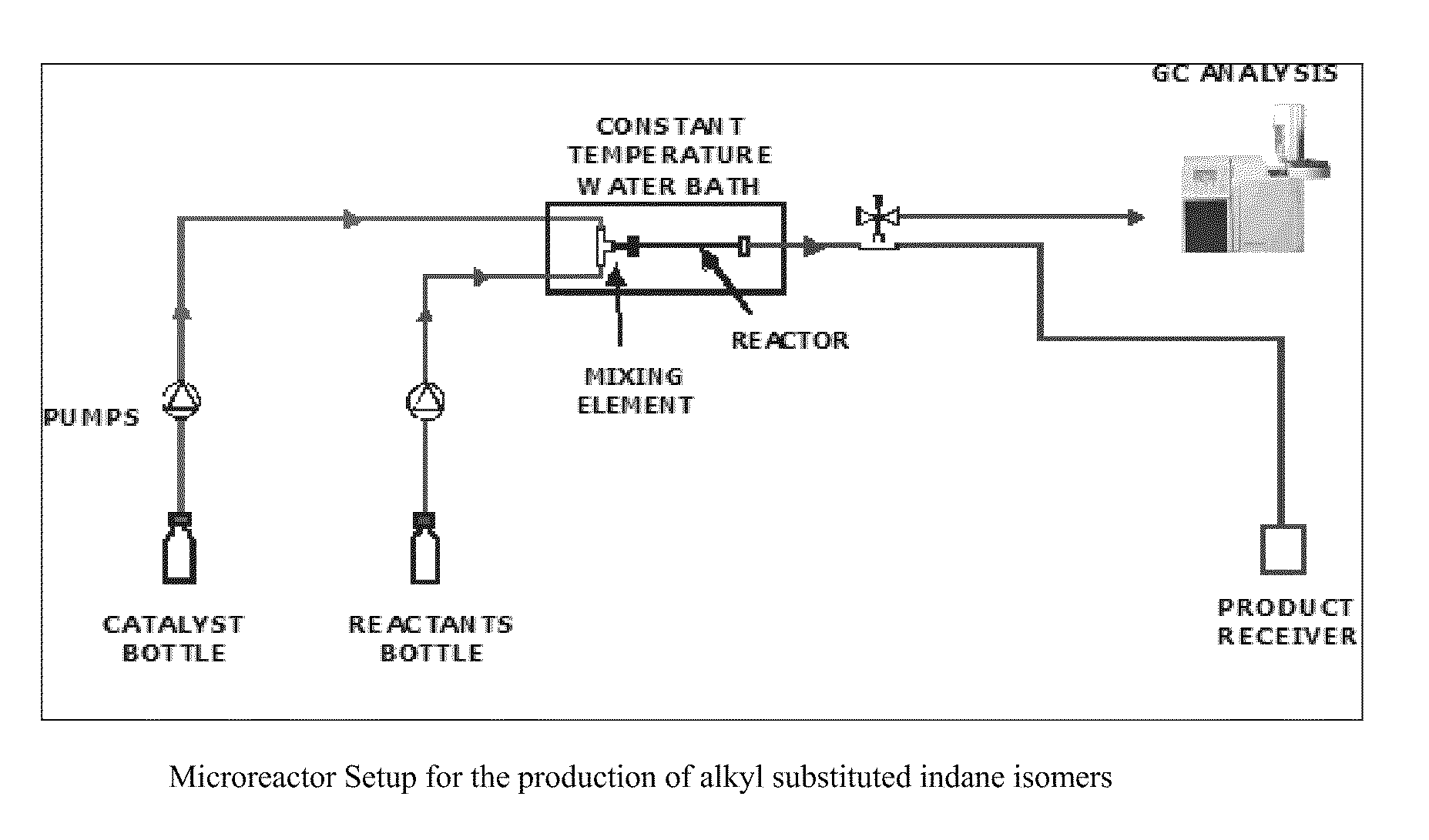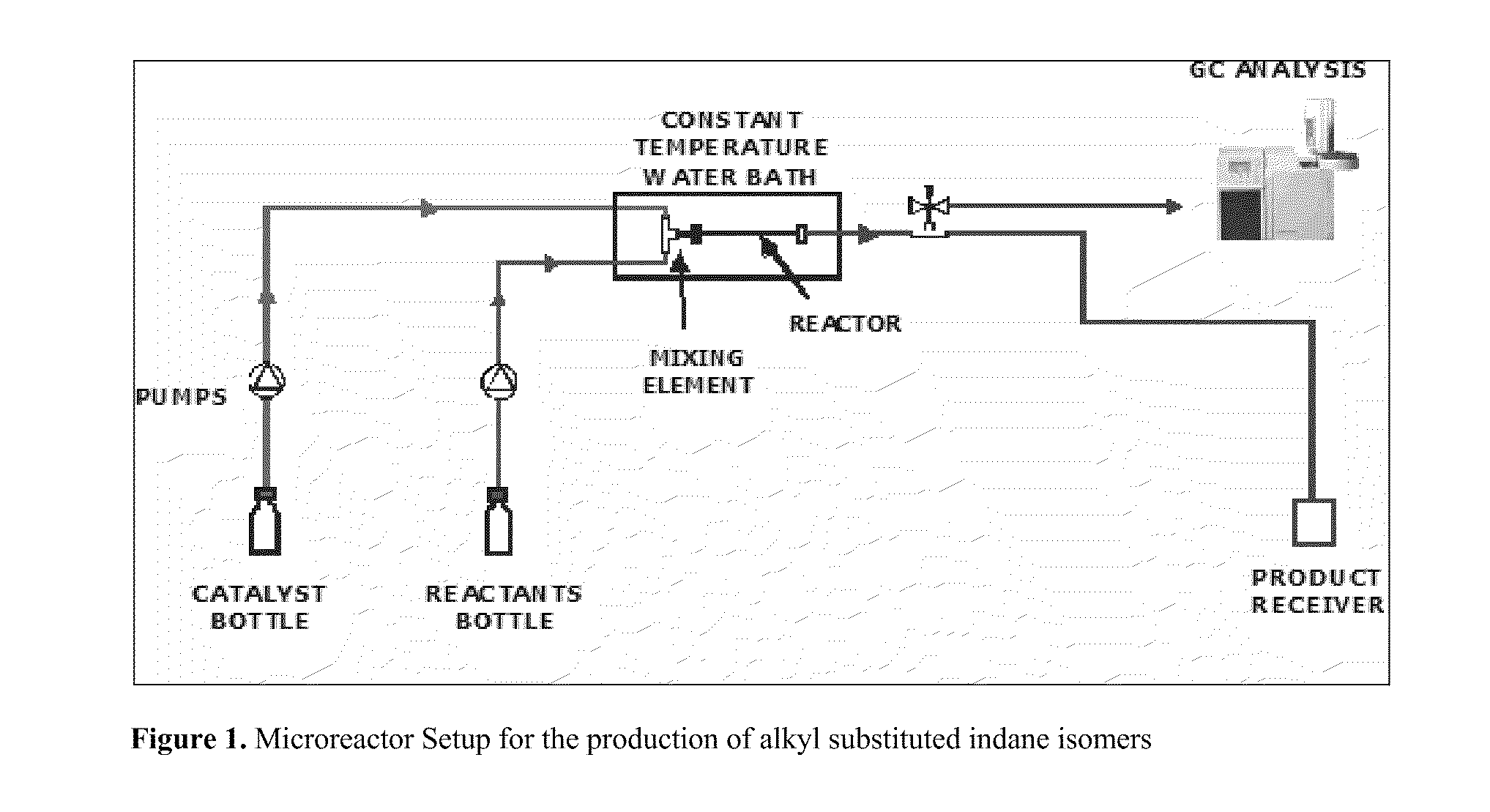Process for Producing Alkyl Substituted Indanes
a technology of indane and alkyl, which is applied in the direction of organic chemistry, chemical apparatus and processes, hydrocarbon preparation catalysts, etc., can solve the problems of huge energy requirements and difficulty in achieving
- Summary
- Abstract
- Description
- Claims
- Application Information
AI Technical Summary
Problems solved by technology
Method used
Image
Examples
example 1
Production of PMI Using 72 Wt % Recycled Sulfuric Acid Catalyst in a Microchannel Reactor
[0017]A mixture of isoamylenes (15 wt % 2-methyl-1-butene and 85 wt % 2-methyl-2-butene) and alpha-methyl styrene at a molar ratio of 1.44 is fed at flow rate of 0.1 mL / min into a 91 cm microchannel reactor with an internal diameter of 2.4 mm. A catalyst stream of 72 wt % recycled sulfuric acid is also fed simultaneously at 0.1 mL / min to the microchannel reactor via a t-shaped mixing element. The reactor is packed with inert glass beads of a size range of 75 to 150 μm, kept at a constant temperature of 38° C. and the system pressure is 0 psig. The product mixture containing organic and acid layers are separated and a sample of the organic layer is analyzed by GC. The yield of PMI is 0.15 g per g reactants. The Space-Time Yield or average reaction rate for the product is 415 g / L.hr, with a residence time of 496 seconds (8 minutes) in the microchannel reactor. The energy or heat removal rate in th...
example 2
Production of PMI Using 90 Wt % Sulfuric Acid Catalyst in a Microchannel Reactor
[0021]A mixture of isoamylenes (15 wt % 2-methyl-1-butene and 85 wt % 2-methyl-2-butene) and alpha-methyl styrene at a molar ratio of 1 is fed at flow rate of 1.5 mL / min into a 6 cm microchannel reactor with an internal diameter of 2.4 mm. A catalyst stream of 90 wt % sulfuric acid is also fed simultaneously at 1.5 mL / min to the microchannel reactor via a t-shaped mixing element. The reactor is packed with inert glass beads of a size range of 75 to 150 μm, kept at a constant temperature of 95° C. and the system pressure is 0 psig. The product mixture containing organic and acid layers are separated and a sample of the organic layer is analyzed by GC. The yield of PMI is 0.643 g per g reactants. The Space-Time Yield or average reaction rate for the product is 424,810 g / L.hr, with a residence time of 2.2 seconds in the microchannel reactor. The energy or heat removal rate in the microreactor under these co...
example 3
Production of PMI Using Filtrol-24 Solid Catalyst in a Microchannel Reactor
[0023]A mixture of isoamylenes (15 wt % 2-methyl-1-butene and 85 wt % 2-methyl-2-butene) and alpha-methyl styrene at a molar ratio of 1 is fed at flow rate of 0.05 mL / min into a 6 cm microchannel reactor with an internal diameter of 2.4 mm. The reactor is packed with Filtrol-24 (a solid acid catalyst) with particle size range of 75 to 150 μm, kept at a constant temperature of 140° C. and the system pressure is 300 psig. The yield of PMI is 0.46 g per g reactants. The Space-Time Yield or average reaction rate for the product is 6 g / g catalyst .hr, with a residence time of 130 seconds in the microchannel reactor. The energy or heat removal rate in the microreactor under these conditions is 4645 kW / m3.
PUM
| Property | Measurement | Unit |
|---|---|---|
| Temperature | aaaaa | aaaaa |
| Pressure | aaaaa | aaaaa |
| Pressure | aaaaa | aaaaa |
Abstract
Description
Claims
Application Information
 Login to View More
Login to View More - R&D
- Intellectual Property
- Life Sciences
- Materials
- Tech Scout
- Unparalleled Data Quality
- Higher Quality Content
- 60% Fewer Hallucinations
Browse by: Latest US Patents, China's latest patents, Technical Efficacy Thesaurus, Application Domain, Technology Topic, Popular Technical Reports.
© 2025 PatSnap. All rights reserved.Legal|Privacy policy|Modern Slavery Act Transparency Statement|Sitemap|About US| Contact US: help@patsnap.com



